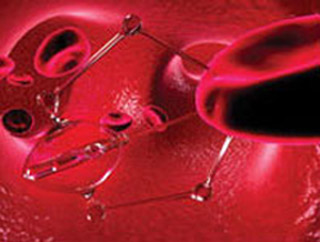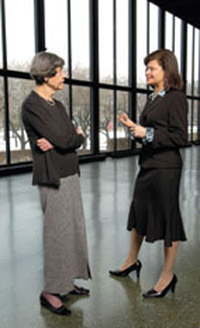Much like genetics, nanotechnology poses difficult questions that extend beyond the laboratory and into our daily lives. The first academic organization in the United States leading the nano ethics debate, IIT’s new Center on Nanotechnology and Society is an interdisciplinary collective of faculty, researchers, and thinkers who are weighing the implications of this young but promising technology.
If researchers have their way, someday we will be able to take an elevator to a space station, marking the end of rockets, or detect cells that are in danger of deforming and stop the process before it begins. What would make it all possible is nano, which is finding its way, increasingly, into our lives. Nanotechnology is the manipulation and manufacturing of materials at the molecular or atomic level. A nanometer—“nanos” in Greek means “dwarf”—is as small as it gets: one billionth of a meter. Eighty thousand nanos equal the width of a human hair. One hundred thousand are the depth of a sheet of paper.
Some have hailed nanotechnology as the next Industrial Revolution. And while it has already been instrumental in developing dozens of products as diverse as dental-bonding agents and car bumpers—and holds the promise of giving us clean energy, better disease diagnosis and treatment, improved power transmission, and products that are lighter and stronger—there is more to address than engineering and scientific challenges. Nanotechnology brings with it a host of ethical and societal implications, making the subject one of today’s most controversial interdisciplinary topics.

The digitally enhanced image illustrates a nanobot working in the bloodstream of a human artery. Among other applications, nanotechnology is being explored for medical uses, where nano devices would travel through the bloodstream to treat diseases and repair tissues at the cellular level. The ethical and societal implications of such work are the focus of IIT’s Center on Nanotechnology and Society.
M. Ellen Mitchell, director of IIT’s Institute of Psychology, says attention to the new technology’s scientific promise hasn’t been accompanied by substantive discussion about personal, social, economic, and legal impacts. Individual issues, she says, merge into societal issues; health issues mingle with consumer concerns, and these areas become inextricably intertwined.
“While we revel in every new power we gain ‘over nature’, technologies in fact give some people power over other people, with ‘nature’ as an instrument.” —Nigel M. de S. Cameron
The discussions surrounding nano are similar to ones that stemmed from the Human Genome Project, the first large-scale scientific initiative to address ethical, legal, and social implications arising from the potential manipulation of genes. But beyond the ethical considerations are very real physiological ones. Certain substances that are safe in larger quantities assume toxic characteristics at the nano level. There is concern that, because they are so small, nanoparticles can move through the body at will, evading barriers that stop larger particles. Comparisons are being made with asbestos, at one time considered a ‘miracle mineral’ until it was discovered that asbestos posed a health risk.
Taking a cue from the past—including the doomed efforts to bring genetically modified food into Europe, which raised public anxiety about safety issues and the “futuristic flavor of technology”—experts have realized the importance of engaging professionals and the public much earlier in the process.
Catalyzing discussions about the implications of nanotechnology is the work of Nigel M. de S. Cameron, associate dean and research professor of bioethics at Chicago-Kent College of Law. Cameron is director of Chicago-Kent’s Center on Nanotechnology and Society (Nano & Society), created in 2005 with a $500,000 Congressional earmark. It speaks to the importance of this burgeoning, but still largely untested, field.
“The ethical implications are huge,” Cameron says. “What does it mean for us, for people, for those who value our common humanity, who want medicine to cure disease and restore function, though not at the cost of commodifying our bodies and brains? What does this mean for those who are aware of the final technological paradox, that the more power we attain to determine ourselves and our children, the more we become creatures of our own design?”
“And, of course, while we revel in every new power we gain over nature, technologies in fact give some people power over other people, with “nature” as an instrument.”
Nano & Society was created as a subset of the Institute on Biotechnology and the Human Future (IBHF), a project initiated by Cameron and Chicago-Kent Distinguished Professor of Law Lori Andrews in 2004 to assess the societal and scientific benefits and risks of new developments in biotechnology.

In its efforts to advance discussion, Nano & Society promotes two key initiatives and national events, such as the recent Washington, D.C., conference “NanoWorld: Toward a Policy for the Human Future.” One initiative is the Chicago Nano Forum, a formal event that is webcast and open to the public. The other is the Nano Colloquium, a more informal biannual IIT roundtable.
The thread running through both initiatives is ethics, which makes the IIT approach unique. There are fewer than 100 American universities paying dedicated attention to nanotechnology and none of the others, according to Cameron, is focused on ethics. Ahead of the National Science Foundation’s (NSF) own key project, “IIT created the first university-based center on nano and society,” he says. “We are on the forefront of the ethics debates.”
Professor Vivian Weil focuses on nothing but ethics.
“As of yet, we know very little about toxic properties of nanotechnology products,” she says. “Sunscreens, for instance it’s the nano compounds that block the sun. But what do these nano compounds do to us? They have not been well tested as far as we know. Are sunscreen nano compounds absorbed by the skin? What are the short- and long-term effects? What effect do discarded bottles and tubes have on disposal sites? Government reports are unlikely, Weil says, since sunscreens are classified as cosmetics and therefore don’t fall under the Food and Drug Administration (FDA) jurisdiction. Another example of an ethical issue is the impact on the workforce. Radically new technologies are disruptive. New manufacturing processes mean that new workers with new skills enter the workforce and formerly valuable workers are no longer needed. Weil says it is essential to look ahead in order to prevent, mitigate, or compensate for harms to current workers, and that discussions should consider which workers get the benefits and which workers bear the burdens of disruptive changes so that benefits and burdens are not unfairly distributed.
Products Containing Nanoparticles
- Step assists on vans
- Car bumpers
- Paints and coatings to protect against corrosion, scratches, and radiation
- Protective and glare-reducing coatings for eyeglasses and cars
- Metal-cutting tools
- Sunscreens
- Longer-lasting tennis balls
- Light-weight, stronger tennis racquets
- Stain-free clothing and mattresses
- Dental-bonding agents
- Burn and wound dressings
- Ink
- Catalytic converters
Source: National Nanotechnology Initiative